Mint is super underrated. In fact, herbs are in general.
We lack knowledge of the benefits because it simply isn't being passed on like it once was.
Ancient cultures used herbs for medicinal purposes and to obtain valuable dietary nutrients, as do many rural communities in Asia, the Middle East and Africa still do today.
FACT: When we introduce herbs regularly into cooking and salads, we considerably increase our natural nutrient intake and improve our health.
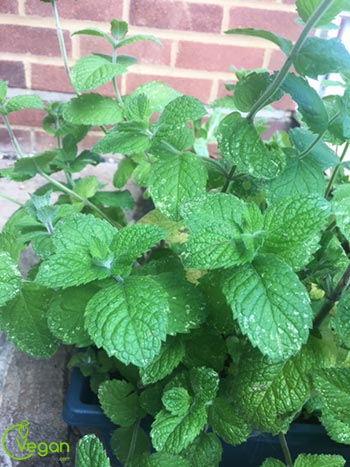
Garden Mint Plant: White patches may appear when the weather has been very wet, though leaf degradation also happens if you don't pick regularly. Don't expect perfect from organic gardening!
The thing about herbs is that they are hardy. Most varieties are easy to grow, especially from a cutting.
And none more so than mint.
Anyone can grow mint, even the most inexperienced grower.
There is a saying in the gardening world: “You never buy mint more than once”.
You take cuttings and replant. Mint never dies, it always bounces back!
Mint comes in so many wonderful varieties too. Right now I am growing the following:
- Standard Mint
- Spearmint
- Apple Mint
- Chocolate Mint
- Basil Mint
Of course you can make lovely tea from mint leaves, but also chop mint up in salads, have it in sandwiches, or add it to dishes like pasta and vegetable stir-fry.
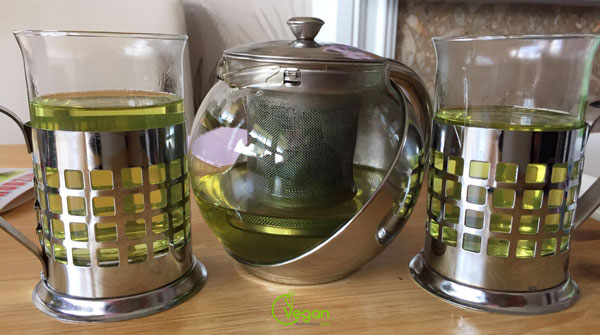
Tea for two, anyone?
6 Tips for Growing Your Own Mint
Mint is super-easy to grow, and it won't take any skill at all to get some going from a cutting or small plant. You can try from seed too, if you have the patience.
Tip 1: Planting Mint
Grow in pots or tubs. Don't put mint in the ground. It's roots tend to grow sidewards and it will just take over. It's so easy to grow that it spreads like wildfire.
Mint can withstand most weather, but I find best results are seen from a spot that receives early morning/late afternoon sun and moderate shade for the rest of the day.
If in a tub/pot, bring it close to the house at night (where it is warmer) in cold weather.
Tip 2: Feeding Your Mint
You don't need to use artificial grow liquids. Just plant in good soil (buy some from your garden centre).
If growing indoors, collect rain water in a buck/buckets and feed to your plants when dry. Don't overwater but look out for limpness and signs of dehydration.
Tip 3: Harvesting Your Mint
To be honest, mint will just grow back no matter how hard you hack it off. But don't! Be gentle.
If you pick leaves, hold the stem steady with one hand and pick with the other.
However, it's best to either cut a whole stem off at a branch point (just above where two leaves have sprouted either side), or prune leaves off with some sharp scissors so the cut is accurate.
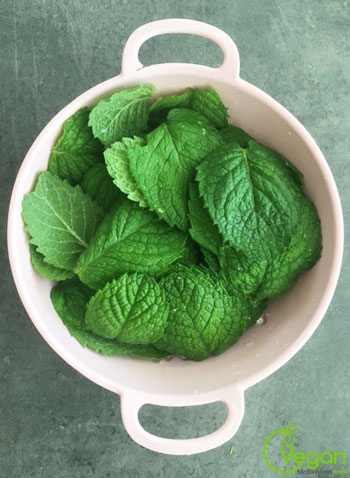
A lovely fresh harvest to be used in salad and cooking.
Tip 4: Cut & Come Again
When mint starts to flower, cut the stems down, use the leaves and let it come again. Once every couple of weeks, go through the plant and check for any dead leaves gathering at the bottom of the pot and remove them. Rotting leaves can encourage fungal diseases.
Tip 5: Avoiding Pests & Sick Plants
Depending on the type, mint can become limp and suffer from the effects of frost and bugs like earwigs and worm-type bugs. You don't need to worry about slugs or snails much as they generally don't like mint and other herbs.
My advice is to keep your mint in fairly tall pots and close to the house, if possible. But not in a dry, dusty area as these conditions will attract mites (see more in the diseases section towards the bottom of the page).
If your mint is looking sick, don't worry. Just cut it right down to the stems and watch it bounce right back. I did that with my Apple Mint recently and look how it is growing back already (see below):
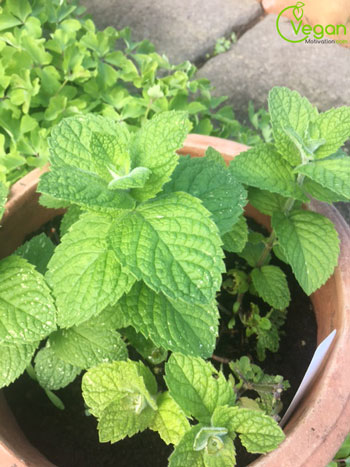
My apple mint bounces back within 2 weeks of being chopped to the core!
✓ Click here to buy mint seeds (delivered to your door)
Tip 6: Pruning & Sharing
Share your mint. Pruning encourages growth and new, healthy leaves. Give excess leaves to friends for tea and salads, and pass on cuttings to friends so they can root and grow their own.
Nutritional Benefits of Mint
Mint is superb. Look at all the wonderful micronutrients it contains:
- Thiamin
- Niacin
- Vitamin B6
- Phosphorus
- Zinc
- Vitamin A
- Vitamin C
- Riboflavin
- Folate
- Calcium
- Iron
- Magnesium
- Potassium
- Copper
- Manganese
Mint is a source of protein too – as are all plants – and has a strong amino acid profile. It is also a good source of dietary fiber.
Brain Power & Alertness
Even smelling mint is good for you. According to research from Wheeling Jesuit University, the smell or flavor of peppermint can improve cognitive functions, including reasoning, problem solving, concept formation, judgment, attention span, and even memory.
In 2008, researchers in England looked at the link between peppermint scent and brain power. They compared it to the scent of ylang ylang and a control group who received no odor. Those who received peppermint smell increased both alertness and memory. Ylang ylang had the opposite effect.
Mint for a Bad Stomach
Mint is renowned for soothing a dodgy stomach, and even help those with irritable bowel syndrome (IBS). All you need to do is make a tea with some leaves from the mint plant and add boiling water. You can also eat it raw if you like.
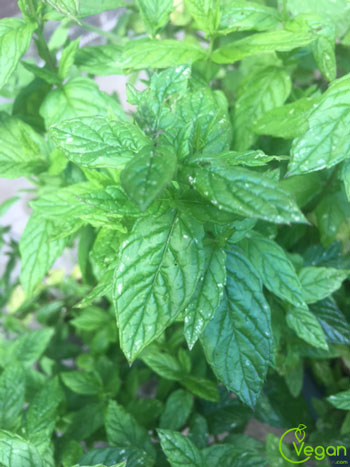
Spearmint flourishes in a wonderful shade of green.
Mint Plant Diseases to Look Out For
1. Mint Rust
Mint rust is caused by a rust fungus (Puccinia menthae). It pretty much affects all the mint species as well as some related plants. Symptoms tend to occur from spring until autumn.
You may see the following symptoms on your mint plant:
- Dusty orange pustules (small blister / pimple) on the stems and leaves. These can also appear as dusty yellow or black pustules
- Leaf tissue dying off and leaves dropping.
- Pale shoots in spring time.
What to Do if You Get Mint Rust?
If you have multiple plants, remove the affected plants before the black resting spores are formed and contaminate the soil. You will also need to remove the infected rhizomes (a continuously growing horizontal underground stem which puts out lateral shoots and adventitious roots at intervals.).
This is another good reason to grow mint in seperate pots; because if one plant gets rust it is already isolated from the others.
You can try heat treatment to cure roots for re-rooting, though buying a new mint plant maybe less taxing on your time.
Wash the rhizomes thoroughly in early autumn. Place in hot water at 44ºC (111ºF) (no higher) for 10-12 minutes, then cool in cold water and plant accordingly. Make sure you use a thermometer because 44ºC (111ºF) is very near the maximum temperature a plant can handle.
2. Root Borer
The larval form of the mint root borer damages the leaves and roots. Adults lay eggs along the veins of the plant's leaves, which hatch in 5-10 days. The root borers feed on the leaves they hatched on before they burrow into the soil and attack the roots of the plant. The result is not always devastating but decreases plant health and produces lower quantity and quality of mint oil in the leaves.
How to Avoid Root Borers?
You can naturally control root borers by raking and tossing, and even replacing the upper 2 inches of the soil in late fall when the insects hibernate in the soil.
3. Spider Mites
If you get mites they will most likely be the twospotted spider mite variety. These pests are tiny and have a greenish, brown or reddish color. They lay their eggs on the undersides of mint leaves where they hatch within 4-5 days.
Spider mites are most common during hot, dry weather in mid to late summer. Water your plants properly during dry periods to reduce damage from these pests. Severe infestations can cause leaves to drop from your plant.
How to Avoid Spider Mites
You can use neem oil extract to prevent these pests from spreading and breeding in your mint. A good tip is to avoid planting in dusty areas where conditions are dry. This environment can favor infestations of spider mites and reduce the immunity of a plant to resist infection.
Mint Benefits in a Nutshell…
- Mint is vegan (hooray).
- It's super good for your body.
- It's easy to grow organically without the need for chemical protection.
- You can grow numerous varieties.
- You can cook with it, eat it in salads and make lovely tea.
- It is free (once you have a plant)
How much more encouragement do you need to get growing?!
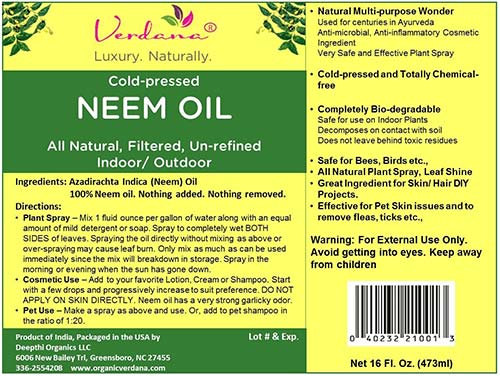
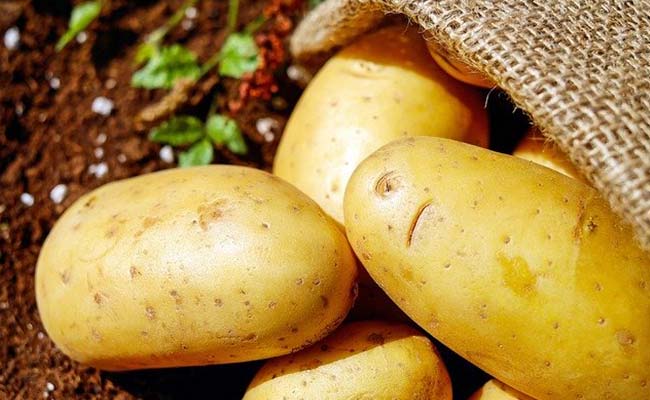
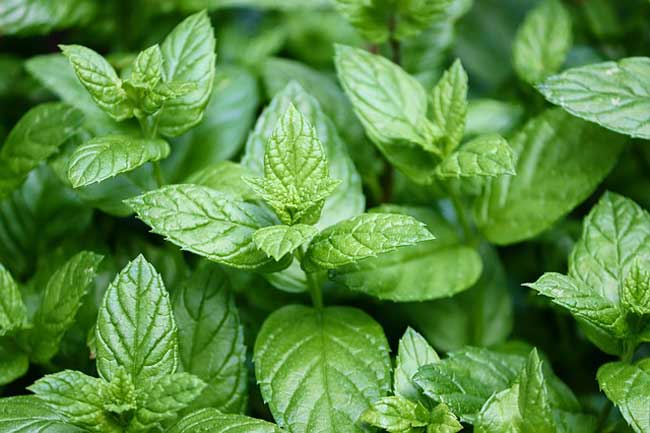

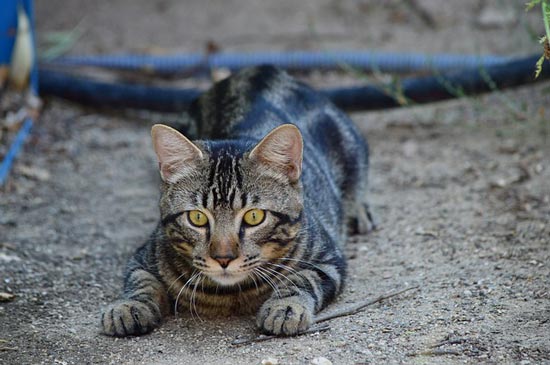
Chocolate Mints are NOT slug resistant at all, at least from my personal experience. I bought seven mature plants, and THREE of them were damaged by slugs on the very first night. They ate the stems together with the leaves, and left slime trails everywhere. I’m currently looking for my receipt, so I can hopefully return the surviving plants back to the store.
Jun 14, 2019 at 9:57 pm
Should also let people know that mint (pepper mint) Is also a good barrier to a lot of bugs that are not good in house/garden. Just plant around the garden edges.
Nov 09, 2017 at 12:29 am
That’s right Edward. I have used spare mint cuttings to protect my veg patch from slugs and snails. It’s only effective for a while though and they soon come in regardless!
Nov 28, 2017 at 4:07 pm